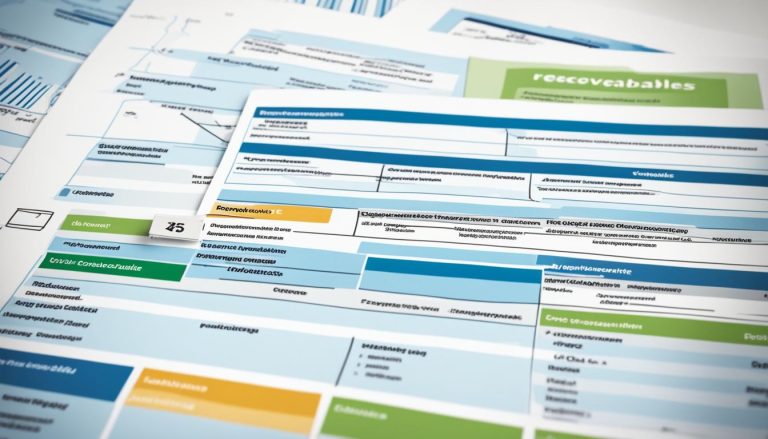Cash flow is crucial for any business. However, it can lead to stress and irritation too. We will look into common cash flow issues businesses face and ways to tackle them.
Challenges include changes in seasons, delayed payments, high ongoing costs, quick growth, laws shifting, and others. With correct strategies, you can maintain a healthy cash flow in your business.
Key Takeaways:
- Recognize the impact of seasonal fluctuations and plan ahead by budgeting and diversifying income streams.
- Negotiate favorable payment terms and consider invoice financing to bridge the gap caused by long payment cycles.
- Monitor cash flow closely and cut unnecessary expenses to manage high fixed costs effectively.
- Balance rapid growth with maintaining cash flow by prioritizing investments and exploring financing options.
- Stay informed about regulatory changes, seek professional advice, and allocate resources to adapt to new requirements.
Seasonal Fluctuations
Seasonal fluctuations are a common challenge for businesses, especially for those in industries with peak and off-peak seasons. These fluctuations can cause cash flow gaps, making covering expenses during slow times hard. Planning ahead with effective strategies is key to overcoming this issue.
Budgeting and Cash Flow Forecasting
One key strategy is effective budgeting. A detailed budget lets you allocate resources for different seasons. This helps spot potential cash flow gaps early and address them.
Cash flow forecasting tools are also helpful. They analyze past data and predict future income and expenses. This gives you a clear view of your cash flow year-round. With this info, you can tweak your spending and saving to make sure you have enough money during slow months.
For instance, if sales dip in winter, cash flow forecasting can show how much cash you’ll need. By saving more during busy months, you can fill the cash flow gap and keep your business stable all year.
Diversify Your Income Streams
Relying on one product or service can make seasonal dips harder. Diversifying your income can soften this blow. Look into offering related services or entering new markets to make money in the slow season.
For instance, a landscaping business might offer snow removal or indoor plant care in winter. This keeps money coming in and reduces reliance on one revenue source. It’s a smart way to handle seasonal dips.
Strategies to Overcome Seasonal Fluctuations
| Strategy | Explanation |
|---|---|
| Budgeting | Create a detailed budget to allocate resources effectively and identify potential cash flow gaps. |
| Cash Flow Forecasting | Utilize forecasting tools to project income and expenses, allowing for adjustments in spending and saving habits. |
| Diversify Income Streams | Offer complementary services or expand into new markets to generate revenue during slower periods. |
By using these strategies, you can lessen the effect of seasonal fluctuations on your cash flow. Planning, budgeting, and diversifying income will keep your business financially stable year-round. It’s important to keep an eye on market changes and adapt your strategies accordingly.
Long Payment Cycles
Are you dealing with late payments and it’s affecting your cash? You’re not alone. Many companies struggle with this, especially in some industries. This issue can lead to not having enough cash and trouble paying bills.
One way to deal with long payment cycles is to talk about payment terms with your buyers. You can ask for a deposit or give discounts for paying early. This can help you get money coming in regularly. It gives you control over your cash and keeps your business stable.
“By establishing favorable payment terms, such as asking for deposits or offering discounts for early payments, you can mitigate the impact of long payment cycles and improve your cash flow situation.”
Considering invoice financing or factoring services is another smart move. These choices give you cash right away for your unpaid invoices. So, you don’t have to wait to get paid. With invoice financing, you turn what you’re owed into cash. This boosts your cash flow and gives your business more liquidity.
Benefits of Negotiating Payment Terms:
- Improved cash flow management
- Enhanced financial stability
- Increased control over cash flow gaps
- Stronger supplier relationships
Talking about payment terms and looking into invoice financing can really help with cash flow issues. Making sure you get paid on time and keeping your cash in check are key for your business to succeed.
| Invoice Financing Providers | Minimum Invoice Value | Service Fee |
|---|---|---|
| Company A | $10,000 | 2.5% |
| Company B | $5,000 | 3.0% |
| Company C | $2,000 | 3.5% |
Check out invoice financing options that fit what your business needs. Here are a few examples:
- Company A: Minimum invoice value of $10,000 with a service fee of 2.5%.
- Company B: Minimum invoice value of $5,000 with a service fee of 3.0%.
- Company C: Minimum invoice value of $2,000 with a service fee of 3.5%.
Getting ahead of long payment cycles means less cash flow problems for your business. Don’t forget, talking about payment terms and using invoice financing can greatly help in managing your cash flow.
High Fixed Costs
Some industries struggle with high fixed costs that don’t change, even if sales do. Costs like rent, utilities, and equipment add pressure to your cash flow. It’s crucial to manage these well to keep your finances stable.
Tracking your cash flow is key. Watching your money helps you spot problems early. By often checking your cash flow, you can see if you’re spending more than you’re making. This lets you fix issues before they get worse.
Lowering fixed costs is very important. Look closely at your expenses to find cuts that don’t hurt your product’s quality. Renegotiating deals or using cheaper equipment can save money without loss of quality.
“Cutting unnecessary expenses plays a vital role in managing high fixed costs. By identifying areas where costs can be reduced without sacrificing quality, businesses can optimize their cash flow and improve financial stability.”
Talk to suppliers or landlords about lowering costs. Mention your loyalty and how reducing costs helps both of you. This can lead to better deals.
Here’s how smart cash management and cutting costs help your finances:
| Metrics | Year 1 | Year 2 |
|---|---|---|
| Total Revenue | $500,000 | $550,000 |
| Total Expenses | $400,000 | $450,000 |
| Net Cash Flow | $100,000 | $100,000 |
In year one, income goes up but so do expenses, keeping cash flow the same. Year two shows how managing costs well maintains steady cash flow. This keeps your business solid.
By focusing on your finances and negotiating well, you can control high fixed costs. These strategies help you build a strong financial base for your business.
Rapid Growth
As your business grows quickly, it’s an exciting but challenging time. Managing cash flow is key for success and sustainability. By controlling your cash flow, making smart investments, and choosing the right financing, you’ll handle the financial demands of expanding well.
Keeping track of money coming in and out is vital during fast growth. Always monitor your cash flow statements and plan for future needs. This strategy helps spot any financial gaps early on and address them.
- Regularly review your projected cash flow to anticipate any shortfalls.
- Identify areas where you can optimize expenses without compromising your growth trajectory.
- Ensure you have a buffer of cash reserves to handle unexpected expenses or emergencies.
It’s crucial to invest in areas that match your growth strategy. Decide which parts of your business need funding now and act accordingly. Prioritizing investments lets you focus on what boosts your growth while protecting your finances.
When it comes to funding growth, consider different options:
- Raising capital from investors or venture capitalists, allowing you to tap into external funds.
- Utilizing crowdfunding platforms to engage with potential backers who believe in your business’s growth potential.
- Applying for business loans or lines of credit from financial institutions.
- Exploring government grants or subsidies that support businesses in high-growth sectors.
- Creating strategic partnerships that provide access to additional resources and support.
Remember, balancing financing growth with healthy cash flow is important. Avoid overusing resources in the quest for expansion. It’s vital to have enough cash for daily expenses and to support growth.
To show how rapid growth affects cash flow, see this table:
| Year | Revenue | Expenses | Net Cash Flow |
|---|---|---|---|
| Year 1 | $500,000 | $400,000 | $100,000 |
| Year 2 | $1,200,000 | $900,000 | $300,000 |
| Year 3 | $2,500,000 | $1,800,000 | $700,000 |
The table shows a business growing over three years. As income grows, so do expenses, affecting net cash flow. Managing the increase in both revenue and expenses is vital for maintaining healthy cash flow.
By managing cash flow well, making careful investments, and finding good financing, you can overcome rapid growth challenges. This will help set your business on a path to lasting success.
Regulatory Changes
Regulatory changes are key in shaping business cash flow and operations. New laws and standards need constant monitoring. It’s vital for businesses to be well-informed to cut costs or lower risks linked to these changes.
Sticking to regulatory standards is crucial to dodge penalties and keep a strong market reputation. Knowing and following the newest regulations helps avoid cash flow problems.
Businesses can take several steps to manage regulatory changes effectively:
Educate Yourself and Stay Informed
Monitor news from industry-specific regulators and government agencies. Knowing about upcoming changes early helps your business prepare and foresee impacts.
Consult with Professionals
Seek insights from experts like consultants or legal advisors who know your industry’s regulations well. They offer valuable advice on staying compliant and managing changes without high costs or risks.
Allocate Resources for Compliance
Set aside resources to watch, adjust, and apply needed changes for compliance. This may mean training staff, updating processes, or investing in new tech solutions.
Review and Adjust Business Strategies
Regularly check your business strategies with regulatory changes in mind. Think about how changes affect cash flow. Adjust pricing, costs, or product offerings to stay competitive and compliant.
By being informed, seeking expert advice, and preparing for compliance, businesses can handle regulatory changes well. Adapting to these changes means following the law and showing dedication to financial stability over time.
| Benefits of Effective Compliance with Regulatory Changes | Strategies for Mitigating Risks and Minimizing Costs |
|---|---|
| 1. Enhanced reputation and customer trust | 1. Keep informed about upcoming regulatory changes |
| 2. Avoidance of penalties and legal issues | 2. Seek professional advice and guidance |
| 3. Improved operational efficiency | 3. Allocate resources for compliance |
| 4. Competitive advantage in the market | 4. Review and adjust business strategies |
| 5. Stronger relationships with stakeholders |
Standardization and Centralization
Standardization and centralization are key in managing cash, bringing cost savings and better efficiency. Still, some challenges can surface when units or subsidiaries have special needs for managing cash. A mix of standardization with flexibility can solve this.
By creating a standardized cash management system that adjusts for different units’ needs, companies can balance standardization and flexibility, improving cash management.
Putting technology to work is a must for making cash management smoother and quicker. Automated tools help businesses handle cash flow better, support smart decision making, and strengthen financial control.
Benefits of Standardization and Centralization
Standardization and centralization have several perks:
- Cost Savings: Making processes standard and bringing cash management together cuts down on extra work and lowers costs.
- Efficiency: By centralizing cash management, companies get a clearer view of their cash and operations become smoother.
- Accuracy: Using one format for reports and automating data handling reduces mistakes and makes data more reliable.
- Risk Reduction: With centralized management, firms can better manage risks, follow rules, and avoid problems.
Adopting standardization and centralization in managing cash has big advantages. But, finding the right mix of standard methods and the needed flexibility for different parts of the organization is key.
| Standardization and Centralization | Benefits |
|---|---|
| Cost Savings | Less spending through cutting unnecessary steps and combining processes. |
| Efficiency | Smoother operations and better insight into cash status. |
| Accuracy | Fewer errors with common reporting styles and automated data processes. |
| Risk Reduction | Stronger risk management and adherence to laws. |
Finding the perfect mix of standardization and adaptability is crucial for better cash management and financial health. With tech solutions and a customized approach, companies can oversee cash flow well, lower risks, and decide financially with confidence.
Bank Data Volume
Handling data from several banks is hard and often leads to mistakes. But, using tech can change the game. It lets you gather data easily, making things more efficient. This cuts down mistakes. Tools like cash management software help you see all your cash info in one place.
Making bank reports consistent and managing data better helps too. By using tech smartly, you can tackle big data challenges. This helps you understand your cash flow better.
To illustrate the impact of technology automation on data management and consolidation, consider the following table:
| Bank | Data Volume (in GB) |
|---|---|
| Bank A | 500 |
| Bank B | 300 |
| Bank C | 200 |
Integrating several banks into one software saves loads of time. It makes data handling smooth. This lets you focus on the important stuff. With tech, managing your cash becomes a breeze.
To visualize the benefits of automation, take a look at the diagram below:
Automated Data Collection and Consolidation Process
“Technology automation makes gathering and combining data from different banks easy. It saves time and cuts down on mistakes. With all data in one place, making money decisions gets easier.”
Manual and Time-Consuming Processes
Relying on manual cash management methods can be challenging and prone to mistakes. Tasks like paper reporting and entering data by hand take up too much time. They also make it easier for errors to happen. It’s the right moment to improve your cash handling ways. It’s a good idea to start using automated systems to make everything smoother and more efficient.
Adopting cash management software can change how you manage your cash flow. With automation, you won’t have to manually enter data or manage lots of paper anymore. This advanced software automates regular tasks. This saves your time and resources, letting you focus on planning and making decisions.
Technology like cash forecasting, liquidity management, and payment processing gives you immediate insights into your cash status. You won’t have to go through tons of paper or wait a long time for reports. These tools provide precise and current information. They help you make quick and well-informed choices.
“Automation is the key to unlocking efficiency in cash management, allowing you to focus on growing your business and seizing new opportunities.”
Benefits of Automation in Cash Management
Now, let’s look at the advantages of using automation and cash management software:
| Benefits | Description |
|---|---|
| Increased Efficiency | Automation eliminates manual tasks, reducing the risk of errors and significantly improving efficiency. |
| Real-time Visibility | With automated processes, you gain instant access to accurate cash flow information, enabling proactive decision-making. |
| Streamlined Workflows | Automated workflows reduce bottlenecks and ensure seamless collaboration between team members. |
| Improved Accuracy | By minimizing manual data entry, automation decreases the likelihood of errors and enhances the overall accuracy of your financial data. |
| Enhanced Cash Flow Management | Automation enables you to monitor and analyze cash flow trends, empowering you to take proactive steps to optimize your financial position. |
By adopting automation and cash management software, you transform how you handle cash. This moves you away from manual methods. It saves time, reduces mistakes, and provides real-time info. Welcome efficient cash flow management into your business.
Settlements/Transactions in Multiple Currencies
Dealing with money in different currencies is tricky. You need a good plan to handle cash flows and avoid risks. A central cash management system is key for managing multiple currency accounts. This makes it easier to see and control your cash, helping you make smart choices.
Automated tools for changing currencies simplify the process. They make payments smooth and save you time and effort. This way, you get accurate and on-time transactions without the hassle.
It’s also smart to have a plan for dealing with currency risks. Getting help from banks that know a lot about currency risks can give you helpful advice and strategies.
Benefits of automated currency conversion:
- Saves time and effort in manual currency conversions.
- Reduces the risk of errors in currency conversions.
- Streamlines payment processing for international transactions.
By taking these steps, you’ll be well-equipped to handle the challenges of using different currencies. This ensures steady cash flow and effective risk management.
| Challenges | Solutions |
|---|---|
| Managing cash flow in multiple currencies. | Implementing a centralized cash management system. |
| Streamlining currency conversions. | Using automated currency conversion tools. |
| Mitigating currency risks. | Establishing currency risk management programs and working closely with banks. |
Remember Your Cash Reserves
Being a business owner means understanding the value of cash reserves. Putting money aside when times are good provides a backup for slower periods. This ensures your business keeps running smoothly. Cash reserves are your safety net for when money gets tight, helping with unexpected costs and maintaining stability.
Think of cash reserves as special savings for necessary expenses and emergencies. These funds should stay untouched unless it’s really needed. With cash reserves at hand, you won’t have to panic over finances or make rushed decisions that could hurt your business later.
To build your reserves, practice smart financial management. Start saving a part of your profits when business is booming. Even a small, regular saving can help grow your reserves over time.
It might be tempting to spend extra cash on expanding or other projects. But, make sure to focus on building reserves when you can. A strong cash reserve is vital during tough times or unexpected events, like a market change or business issues.
“Cash reserves provide a safety net, offering peace of mind and financial stability for your business.”
Create a plan for managing your cash that sets clear goals for your reserves. Figure out how much money you need to cover a few months of expenses. Think about the ups and downs in your business and any industry-specific risks.
Remember, creating cash reserves is an ongoing effort. Keep an eye on your cash flow and tweak your savings plan as necessary. The aim is to have enough in reserves to support your business through any challenges.

Benefits of Building Cash Reserves
The advantages of having cash reserves include:
- Protection against sudden expenses and emergencies
- Covering costs during slow business periods
- The option to take advantage of new opportunities or invest in growth
- Stability during economic struggles or market changes
- Knowing you have a financial safety net gives you confidence and peace of mind
By focusing on cash reserves, you protect your business from money troubles and set it up for long-term success.
Building Cash Reserves: The Bottom Line
Cash reserves aren’t just spare money to be spent. They’re savings meant for essential expenses and emergencies. Saving cash reserves when business is good shields you from financial issues.
Set a goal for your cash reserves, keep an eye on your cash flow, and adjust your saving approach as needed. Building these reserves takes discipline and careful financial planning, but the rewards and security are worth it. Start prioritizing your business’s financial health by building cash reserves now.
Conclusion
Cash flow problems are normal for companies. But, with proper strategies, they can be handled well. Addressing issues like seasonal changes, delayed payments, high costs, fast growth, and new laws helps keep cash flow smooth and stabilizes finances.
Using automated systems to simplify tasks is a good strategy. So is keeping up with new regulations and getting better payment conditions. It’s important to save money for tough times, to have a backup plan.
Cash flow is crucial for your business. By managing cash well and tackling problems head-on, your company can grow and thrive in the future.








